
This is likely what happened to the juvenile sharks at Pulau Hantu – fisherman may have tried to free the entangled individuals from the gill net, but the sharks were hurt in the process and eventually died.
The impact of ALDFG has been well-documented elsewhere, but only recently has the extent of the problem been quantified in Singapore. From 2000 to 2019, nearly 25,000 instances of ALDFG have been recorded in Singapore, with fishing lines and nets comprising 37 per cent and 34 per cent of the dataset respectively.
Even after being lost, relatively intact fishing gear continues to do what it does best – catch or trap marine creatures. This issue is also termed “ghost fishing”. The nets will continue to entangle marine organisms until they disintegrate, but that can take months or years.
Moreover, as a fishing gear disintegrates in the water, it releases microplastics. Besides the negative effects of microplastics on marine and freshwater organisms, such as delaying growth and shortening life spans, there could be health implications for people who consume them in turn.
While it’s not possible to pinpoint the source of ALDFG, the majority of lines and some nets found in Singapore were most likely first used in our own shorelines and waters.
MINIMISING DESTRUCTIVE FISHING PRACTICES
As fishing continues to rise in popularity, the use of more destructive fishing gears needs to be heavily monitored or even restricted.
As things stand now, there is limited legal protection for vulnerable species and juvenile fishes. Although NParks recommends practicing catch-and-release, it is difficult to enforce this practice among recreational fishers.

